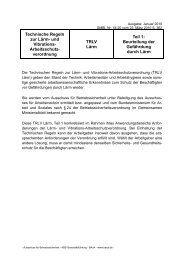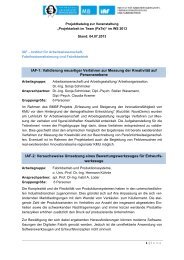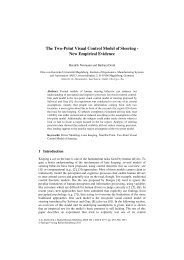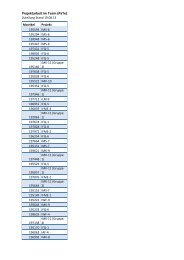Weber Schaetzle Hulin Preusche und Deml _ ... - OvGU::FMB::IAF
Weber Schaetzle Hulin Preusche und Deml _ ... - OvGU::FMB::IAF
Weber Schaetzle Hulin Preusche und Deml _ ... - OvGU::FMB::IAF
Create successful ePaper yourself
Turn your PDF publications into a flip-book with our unique Google optimized e-Paper software.
have been detected when adding distance information [20] [21]. For<br />
this reason, it seems to be more interesting to concentrate on the<br />
encoding of direction. Particularly, the number and the optimal<br />
configuration of tactors still need further research. Thus, our first<br />
research question addresses whether a higher degree of spatial<br />
resolution increases the user’s performance or not. Similarly, it is<br />
still unclear how well vibrotactile feedback is actually suited for<br />
providing spatial guidance. This question can only be answered<br />
when contrasting it to another feedback modality. Within the context<br />
of navigation, verbal guidance has shown to be effective [22] [23].<br />
Thus, our second research question focuses on the direct<br />
comparison of both modalities.<br />
3 THE VIBROTACTILE FEEDBACK DEVICE VIBROTAC<br />
VibroTac is a vibrotactile feedback device which was developed at<br />
the German Aerospace Center (DLR). It is used to apply vibrotactile<br />
stimuli to the human arm [24].<br />
In previous psychophysical studies, the alignment, number and<br />
type of vibration motors of a vibrotactile wrist band have been<br />
investigated [25]. Experiments to determine the spatial acuity<br />
revealed that a configuration with six actuators distributed on the<br />
arm’s perimeter in equal distances is a good compromise between<br />
the number of feedback locations and reliable detection of feedback<br />
locations when compared with configurations of four and eight<br />
actuators [25].<br />
Due to the ergonomic concept of the device, it can be worn on a<br />
wide range of arm diameters while battery power and a wireless<br />
control interface contribute to unrestricted freedom of movement<br />
and user convenience.<br />
Figure 1. The vibrotactile feedback device “VibroTac”<br />
Six vibration segments are distributed aro<strong>und</strong> the human arm in<br />
equal distances. Each segment comprises a cylindrical DC vibration<br />
motor which is separately and continuously adjustable in frequency<br />
(0-190 Hz) and shape of stimuli (e.g. impulse, ramp, wave, knock,<br />
trembling).<br />
Up to 64 devices can be controlled simultaneously. This allows<br />
the use of several devices worn on arms or even on legs for<br />
distributed feedback. The maximum data update rate is 1600 Hz (if<br />
several devices are used, the maximum update rate is divided<br />
through the number of devices). The time constant of the motors<br />
itself is approximately 50 ms.<br />
As several persons use the device, hygienic material (plastic) is<br />
used and skin-touching areas are designed to be small in order to<br />
avoid sweating.<br />
4 EVALUATION EXPERIMENT<br />
In a laboratory experiment, we compared vibrotactile guidance<br />
provided by VibroTac and verbal guidance in a tracking task<br />
paradigm. Moreover, we compared vibrotactile guidance with six<br />
and four directional cues to explore whether a higher degree of<br />
spatial resolution results in increased performance.<br />
4.1.1 Methods<br />
Sample<br />
N = 18 (1 female, 17 male) right-handed individuals (employees<br />
of the German Aerospace Center; M AGE= 28.2 years; SD = 5.2 with<br />
an age range from 22 to 43 years) were recruited; none of them had<br />
participated in prior studies on VibroTac.<br />
Assessment of Motor Skills<br />
Participants’ fine motor skills were assessed with the motor<br />
performance test of the Vienna Test System (Schuhfried GmbH).<br />
Based on Fleishman’s taxonomy [26], the precision of arm-hand<br />
movements (“control precision”) was measured in a track tracing<br />
test. Although abilities were distributed normally (Kolmogorov-<br />
Smirnov-Z= 0.85; ns), the mean percentile rank of M = 68.4 (SD =<br />
28.2, Range = 24-100) indicates above-average abilities of the<br />
recruited sample.<br />
Psychophysical Adjustment of Modalities<br />
To guarantee that the perceived stimulus magnitudes are similar<br />
for both guidance modes, we matched the intensities of the<br />
vibrotactile and the acoustical stimuli using the cross modality<br />
matching method developed by Stevens [27]. N = 10 individuals<br />
(who did not participate in the main study) adjusted the stimulus<br />
intensities in one modality to a series of five reference stimuli in the<br />
other modality until they were perceived as being equally strong. In<br />
a similar manner, the other modality had to be adjusted afterwards.<br />
The matching order was randomized for each participant.<br />
As can be seen in Figure 2, the results of both matching orders<br />
were similar.<br />
Figure 2. Results of the cross modality matching<br />
For the main experiment, we chose a moderate so<strong>und</strong> intensity of<br />
63 dB and the corresponding vibrotactile frequency of 73 Hz.








